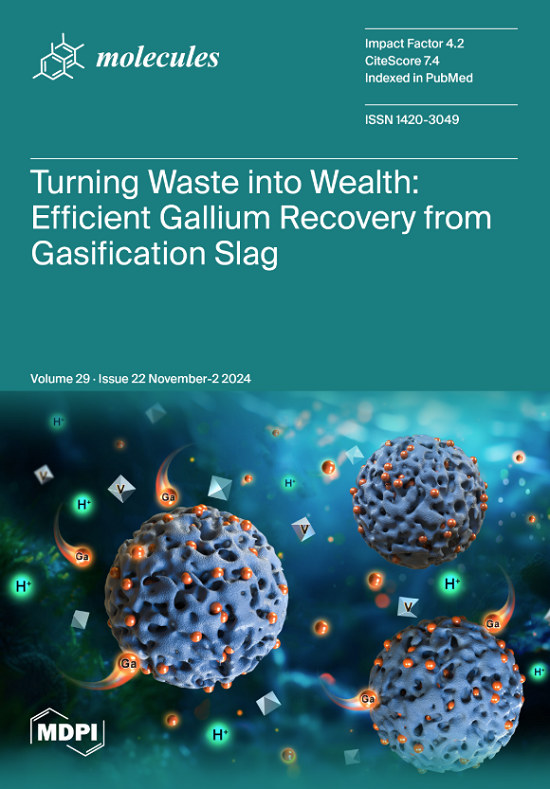Natural Deep Eutectic Solvents for the Extraction of Spilanthol from Acmella oleracea (L.) R.K.Jansen
IF 4.2
2区 化学
Q2 BIOCHEMISTRY & MOLECULAR BIOLOGY
引用次数: 0
Abstract
With a growing focus on green chemistry, the extraction of natural products with natural deep eutectic solvents (NADES), which are eutectic mixtures of hydrogen bond donors and acceptors, has become an ever-expanding field of research. However, the use of NADES for the extraction of spilanthol from Acmella oleracea (L.) R.K.Jansen has not yet been investigated. Therefore, in this study, 20 choline chloride-based NADES, and for comparison, ethanol, were used as green extraction agents for spilanthol from Acmella oleracea flower heads. The effects of time, water addition, and temperature on NADES extractions were investigated and analysed by HPLC-DAD quantification. Additionally, UHPLC-DAD-ESI-MSn results for dichloromethane extracts, as well as the isolation of spilanthol and other main constituents as reference compounds, are reported. The best green extraction results were achieved by choline chloride (ChCl) with 1,2-propanediol (P, 1:2 molar ratio, +20% water) at 244.58 µg/mL, comparable to yields with ethanol (245.93 µg/mL). Methylurea (MeU, 1:2, +20% water) also showed promising results as a hydrogen bond donor in combination with choline chloride (208.12 µg/mL). In further experiments with NADES ChCl/P (1:2) and ChCl/MeU (1:2), extraction time had the least effect on spilanthol extraction with NADES, while yield decreased with water addition over 20% and increased with extraction temperature up to 80 °C. NADES are promising extraction agents for the extraction of spilanthol, and these findings could lead to applicable extracts for medicinal purposes, due to their non-toxic constituents.R.K.Jansen 从油菜籽(Acmella oleracea (L.) R.K.Jansen)中萃取 Spilanthol 的天然深共晶溶剂
随着人们对绿色化学的日益关注,使用天然深共晶溶剂(NADES)(即氢键供体和受体的共晶混合物)萃取天然产物已成为一个不断扩大的研究领域。然而,利用 NADES 萃取油橄榄(Acmella oleracea (L.) R.K.Jansen)中的斯皮兰酚的研究尚未开展。因此,本研究将 20 种氯化胆碱基 NADES 和乙醇作为绿色萃取剂,萃取油菜花中的螺旋藻黄质。研究了时间、加水量和温度对 NADES 提取的影响,并通过 HPLC-DAD 进行了定量分析。此外,还报告了二氯甲烷萃取物的 UHPLC-DAD-ESI-MSn 结果,以及作为参考化合物的螺醇和其他主要成分的分离情况。氯化胆碱(ChCl)与 1,2-丙二醇(P,摩尔比 1:2,+20% 水)的绿色萃取效果最好,为 244.58 µg/mL,与乙醇的产量(245.93 µg/mL)相当。甲基脲(MeU,1:2 摩尔比,+20% 水)与氯化胆碱(208.12 微克/毫升)结合作为氢键供体也显示出良好的效果。在使用 NADES ChCl/P (1:2) 和 ChCl/MeU (1:2) 的进一步实验中,萃取时间对使用 NADES 萃取螺环脂醇的影响最小,而产量则随着水添加量超过 20% 而减少,并随着萃取温度的升高而增加,最高可达 80 °C。NADES 是一种很有前景的提取螺环菌醇的萃取剂,由于其成分无毒,这些发现可能会使其提取物适用于药用目的。
本文章由计算机程序翻译,如有差异,请以英文原文为准。
求助全文
约1分钟内获得全文
求助全文
来源期刊

Molecules
化学-有机化学
CiteScore
7.40
自引率
8.70%
发文量
7524
审稿时长
1.4 months
期刊介绍:
Molecules (ISSN 1420-3049, CODEN: MOLEFW) is an open access journal of synthetic organic chemistry and natural product chemistry. All articles are peer-reviewed and published continously upon acceptance. Molecules is published by MDPI, Basel, Switzerland. Our aim is to encourage chemists to publish as much as possible their experimental detail, particularly synthetic procedures and characterization information. There is no restriction on the length of the experimental section. In addition, availability of compound samples is published and considered as important information. Authors are encouraged to register or deposit their chemical samples through the non-profit international organization Molecular Diversity Preservation International (MDPI). Molecules has been launched in 1996 to preserve and exploit molecular diversity of both, chemical information and chemical substances.
 求助内容:
求助内容: 应助结果提醒方式:
应助结果提醒方式:


